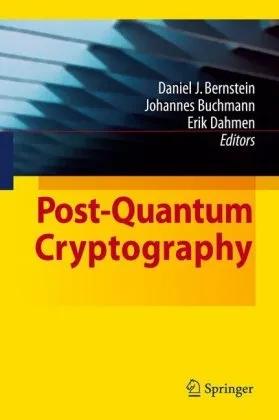Post-Quantum Cryptography
4.5
Reviews from our users

You Can Ask your questions from this book's AI after Login
Each download or ask from book AI costs 2 points. To earn more free points, please visit the Points Guide Page and complete some valuable actions.Introduction to Post-Quantum Cryptography
In an era where the emergence of quantum computing threatens to unravel traditional cryptographic systems, Post-Quantum Cryptography stands as an essential guide for researchers, engineers, and decision-makers navigating this critical transition. Written by experts Daniel J. Bernstein, Johannes Buchmann, and Erik Dahmen, this book provides a comprehensive exploration of cryptographic techniques designed to withstand the computational power of quantum computers.
The science of cryptography has long driven advancements in secure communication and data protection. With traditional methods—such as RSA, ECC, and DSA—becoming vulnerable in a post-quantum world, a new paradigm in cryptographic research has emerged. This book offers an authoritative roadmap for addressing the challenges and opportunities posed by this changing technological landscape.
Detailed Summary of the Book
Post-Quantum Cryptography delves deep into the realm of cryptographic algorithms that are secure against quantum attacks. The book is divided into thematic sections covering an introduction to quantum computing, an explanation of quantum threats to existing cryptographic protocols, and a detailed exploration of quantum-resistant algorithms. It also includes perspectives on standardization efforts and practical implementation strategies for these algorithms.
Each chapter is designed to balance theoretical concepts with practical applications, ensuring readers can apply what they’ve learned in real-world scenarios. The authors introduce mathematical foundations where necessary, breaking down complex ideas into comprehensible explanations. Through examples and case studies, the book elaborates on how cryptographic primitives—like lattice-based cryptography, multivariate quadratic systems, hash-based signatures, and code-based protocols—can be implemented to secure communications in a quantum future.
To make the content approachable, the authors carefully contextualize the material without oversimplifying the science. Whether you're a graduate student, a practicing cryptographer, or a policymaker, this book equips you with the tools and insights to grasp post-quantum cryptography's complexities and its implications for digital security.
Key Takeaways
- The threat posed by quantum computers to traditional cryptographic systems such as RSA and ECC is real and urgent.
- Post-quantum cryptographic systems rely on different mathematical problems for their security, including lattice-based approaches and multivariate quadratic equations.
- Hash-based signatures and code-based cryptography offer viable alternatives to current cryptographic protocols.
- Global efforts, including standardization projects like NIST's Post-Quantum Cryptography Standardization, aim to streamline the selection of future-proof algorithms.
- Post-quantum cryptography is not just a scientific challenge but also a societal and economic one, as secure communication underpins trust and functionality in modern systems.
Famous Quotes from the Book
“Quantum computing doesn't just ask us to think faster—it asks us to think differently about the mathematics of security.”
“Cryptography's resilience has always been measured by its ability to adapt, and post-quantum cryptography is its greatest test yet.”
“Designing systems that last in a post-quantum era is not merely a technological objective but a profound responsibility in securing the future of digital trust.”
Why This Book Matters
The advent of quantum computers heralds a paradigm shift in cryptography, rendering current protocols obsolete. This growing reality sets the backdrop for Post-Quantum Cryptography, making it a vital resource for understanding and navigating the shift toward quantum-resistant security systems. The book’s relevance cannot be overstated in a world where data breaches pose significant risks to individuals, businesses, and governments alike.
What sets this book apart is its comprehensive approach—bridging the gap between foundational theory and its implications for practical applications. The authors’ expertise and foresight make it not just a textbook but a cornerstone in the field of cryptographic research and development. It empowers readers with the knowledge and tools necessary to start developing and implementing systems resilient to quantum computing's impact.
In an age when secure communication is central to modern life—whether for e-commerce, healthcare, finance, or national security—understanding post-quantum cryptography has never been more critical. This book equips its audience to face the inevitable challenges ahead, making a compelling case for its inclusion in academia, industry, and policymaking circles.
Free Direct Download
You Can Download this book after Login
Accessing books through legal platforms and public libraries not only supports the rights of authors and publishers but also contributes to the sustainability of reading culture. Before downloading, please take a moment to consider these options.
Find this book on other platforms:
WorldCat helps you find books in libraries worldwide.
See ratings, reviews, and discussions on Goodreads.
Find and buy rare or used books on AbeBooks.


